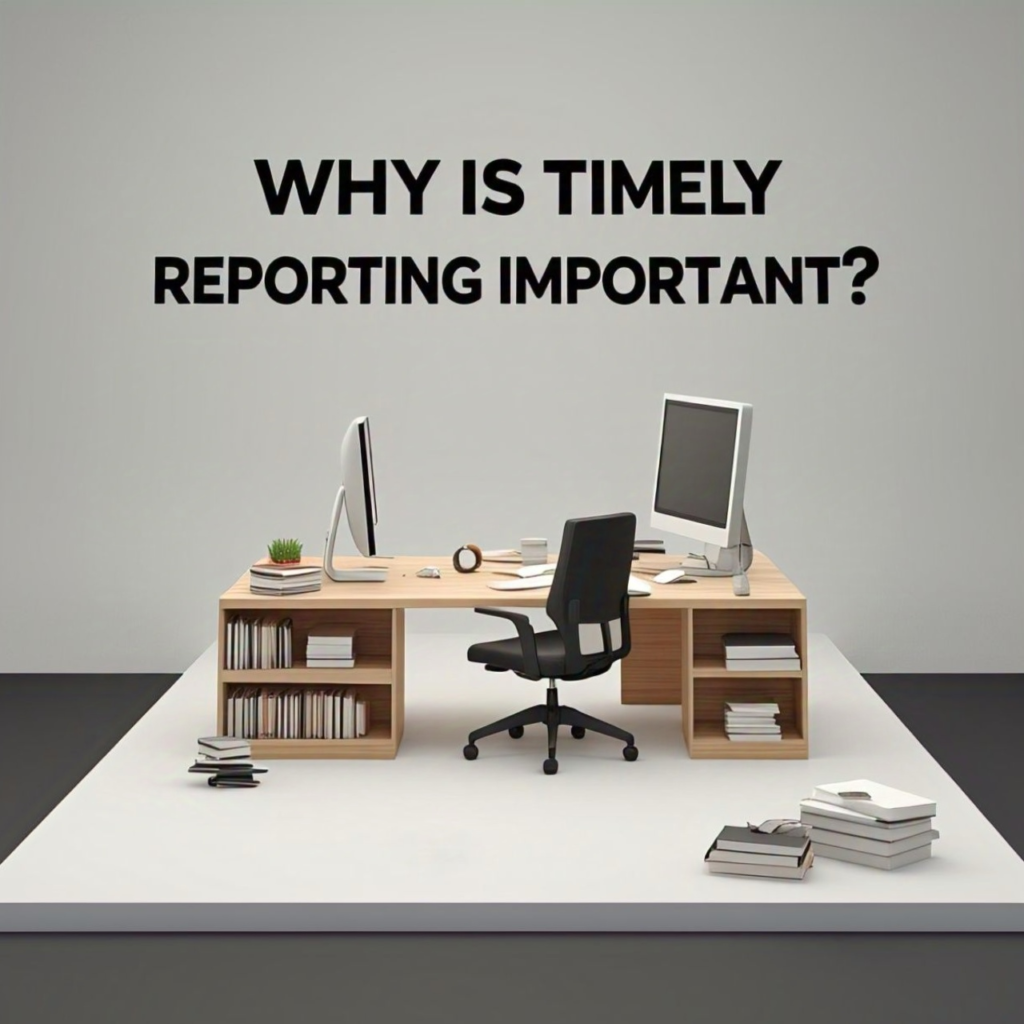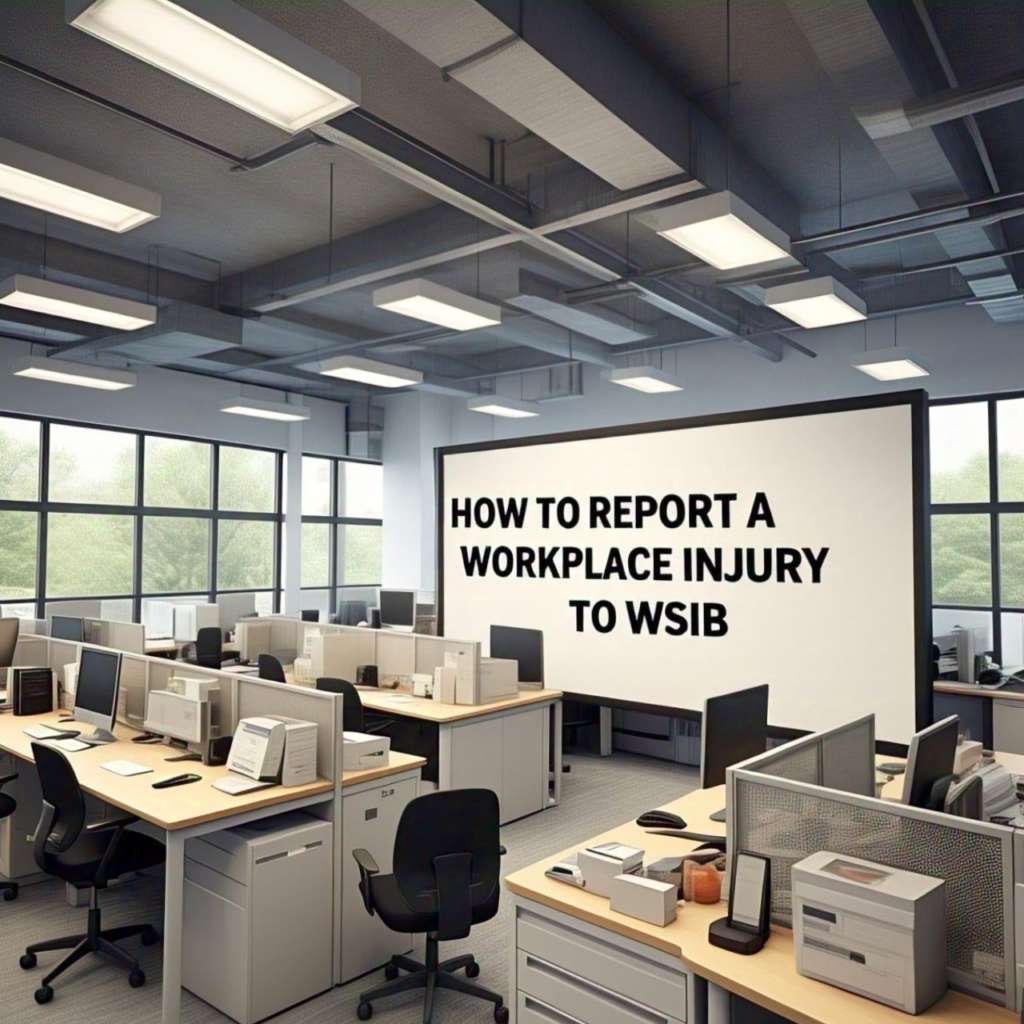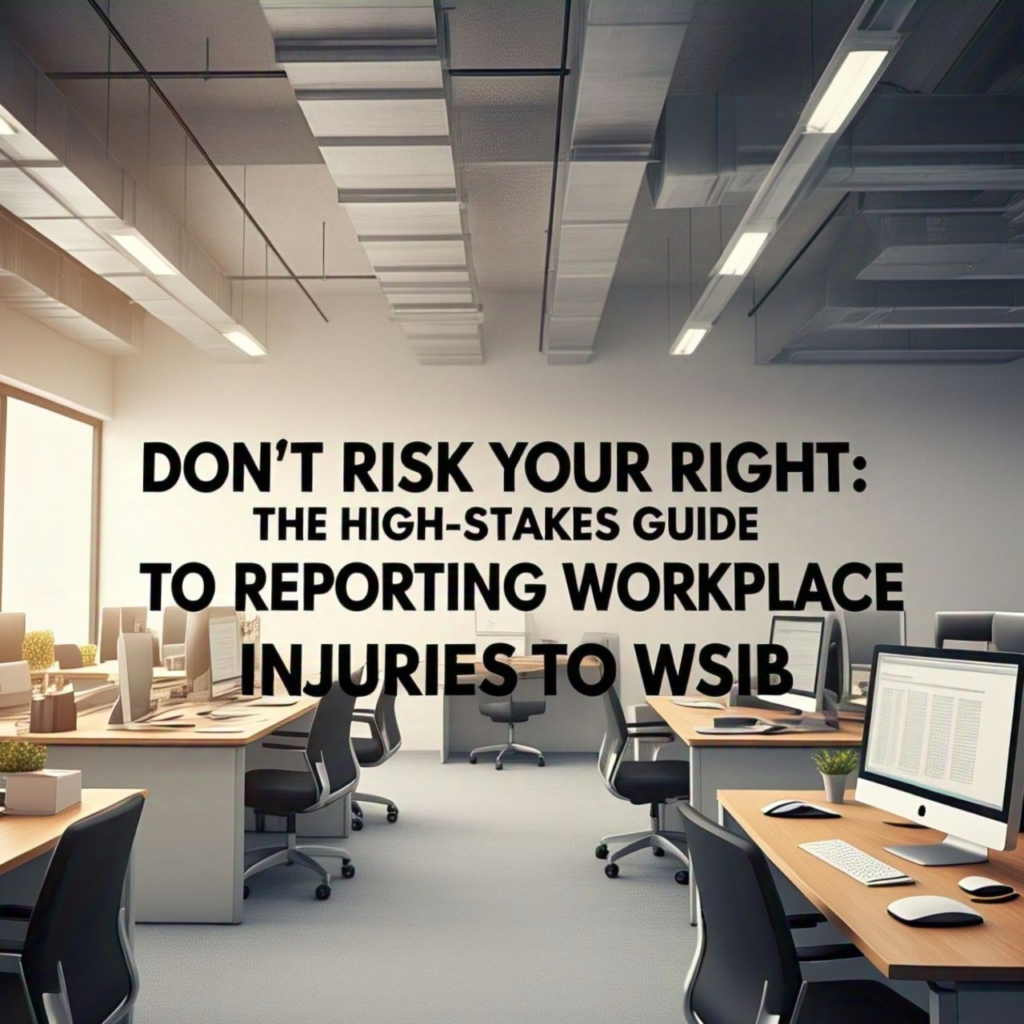DON’T RISK YOUR RIGHT: THE CRITICAL HIGH-STAKES GUIDE TO REPORTING WORKPLACE INJURIES TO WSIB
INTRODUCTION:
Don’t risk your right to compensation, this essential guide to reporting workplace injuries to WSIB outlines the critical steps employers and employees must take to ensure workplace safety, compliance, and protection of their rights.
As an employee in Ontario, Canada, you have the right to a safe working environment. However, accidents can still happen, and it’s essential to know how to report workplace injuries to the Workplace Safety and Insurance Board (WSIB). Failure to do so can result in delayed or denied benefits, leaving you financially vulnerable. In this comprehensive guide, we’ll walk you through the high-stakes process of reporting workplace injuries to WSIB, highlighting the importance of timely reporting, and providing practical solutions to common pain points.
UNDERSTANDING WSIB AND WORKPLACE INJURIES

Before diving into the reporting process, it’s crucial to understand what constitutes a workplace injury and how WSIB works.
WHAT IS A WORKPLACE INJURY?
A workplace injury refers to any physical or psychological harm suffered by an employee while performing their job duties. This can include:
1. Physical Injuries
Physical injuries are the most common type of workplace injury. They can occur due to a variety of factors, such as:
– Slips, trips, and falls: These can occur due to slippery floors, uneven surfaces, or obstacles in the workplace.
– Cuts and lacerations: These can occur due to sharp objects, machinery, or tools.
– Broken bones: These can occur due to falls, accidents, or physical assaults.
– Musculoskeletal disorders (MSDs): These can occur due to repetitive strain, lifting heavy objects, or poor posture.
Physical injuries can have a significant impact on an employee’s ability to work and perform daily tasks. It’s essential to report physical injuries to WSIB promptly to ensure that you receive the necessary medical attention and benefits.
2. Psychological Injuries
Psychological injuries, also known as mental health injuries, can occur due to various factors, such as:
– Workplace stress: This can occur due to excessive workload, lack of control, or poor work-life balance.
– Harassment and bullying: This can occur due to verbal or physical abuse, intimidation, or humiliation.
– Traumatic events: This can occur due to witnessing or experiencing a traumatic event, such as a workplace accident or violence.
Psychological injuries can have a significant impact on an employee’s mental health and well-being. It’s essential to report psychological injuries to WSIB promptly to ensure that you receive the necessary medical attention and benefits.
3. Occupational Diseases
Occupational diseases are illnesses that occur due to exposure to hazardous substances or conditions in the workplace. Examples of occupational diseases include:
– Cancer: This can occur due to exposure to carcinogenic substances, such as asbestos or chemicals.
– Respiratory diseases: This can occur due to exposure to dust, fumes, or other airborne contaminants.
– Skin diseases: This can occur due to exposure to chemicals, allergens, or other substances.
Occupational diseases can have a significant impact on an employee’s health and well-being. It’s essential to report occupational diseases to WSIB promptly to ensure that you receive the necessary medical attention and benefits.
4. Repetitive Strain Injuries (RSI)
Repetitive strain injuries (RSI) occur due to repetitive movements or actions that cause strain on the muscles, tendons, and nerves. Examples of RSI include:
– Carpal tunnel syndrome: This occurs due to repetitive movements of the wrist and hand.
– Tendinitis: This occurs due to repetitive movements of the tendons.
– Bursitis: This occurs due to repetitive movements of the joints.
RSI can have a significant impact on an employee’s ability to work and perform daily tasks. It’s essential to report RSI to WSIB promptly to ensure that you receive the necessary medical attention and benefits.
5. Musculoskeletal Disorders (MSD)
Musculoskeletal disorders (MSD) occur due to injuries or strain to the muscles, tendons, and ligaments. Examples of MSD include:
– Back injuries: This occurs due to lifting heavy objects, bending, or twisting.
– Shoulder injuries: This occurs due to lifting heavy objects, reaching, or throwing.
– Knee injuries: This occurs due to bending, twisting, or lifting heavy objects.
MSD can have a significant impact on an employee’s ability to work and perform daily tasks. It’s essential to report MSD to WSIB promptly to ensure that you receive the necessary medical attention and benefits.
WHAT IS WSIB?
The Workplace Safety and Insurance Board (WSIB) is a Canadian organization responsible for providing workplace injury insurance to employees in Ontario. WSIB’s primary goal is to ensure that workers who suffer work-related injuries or illnesses receive fair benefits and support.
HISTORY OF WSIB
WSIB was established in 1914 as the Workers’ Compensation Board (WCB) to provide financial assistance to workers injured on the job. Over the years, the organization has undergone several name changes and reforms to improve its services and benefits.
ROLE OF WSIB
WSIB plays a crucial role in providing workplace injury insurance to employees in Ontario. Its primary responsibilities include:
1. Providing Financial Benefits: WSIB provides financial benefits to workers who suffer work-related injuries or illnesses, including wage loss benefits, medical benefits, and survivor benefits.
2. Promoting Workplace Safety: WSIB works with employers and workers to promote workplace safety and prevent injuries and illnesses.
3. Investigating Claims: WSIB investigates claims to determine whether an injury or illness is work-related and eligible for benefits.
4. Providing Medical Treatment: WSIB provides medical treatment and rehabilitation services to help workers recover from their injuries or illnesses.
TYPES OF BENEFITS PROVIDED BY WSIB
WSIB provides various benefits to workers who suffer work-related injuries or illnesses, including:
1. Wage Loss Benefits: WSIB provides wage loss benefits to workers who are unable to work due to a work-related injury or illness.
2. Medical Benefits: WSIB provides medical benefits to workers who require medical treatment for a work-related injury or illness.
3. Survivor Benefits: WSIB provides survivor benefits to the families of workers who die as a result of a work-related injury or illness.
4. Rehabilitation Benefits: WSIB provides rehabilitation benefits to workers who require assistance to return to work.
ELIGIBILITY FOR WSIB BENEFITS
To be eligible for WSIB benefits, a worker must:
1. Be Employed in Ontario: The worker must be employed in Ontario and subject to the Ontario Workplace Safety and Insurance Act.
2. Suffer a Work-Related Injury or Illness: The worker must suffer an injury or illness that is related to their work.
3. Report the Injury or Illness: The worker must report the injury or illness to their employer and WSIB within the required timeframe.
HOW WSIB IS FUNDED
WSIB is funded by employer premiums, which are based on the employer’s payroll and industry classification. The premiums are used to pay for benefits and administrative costs.
THE IMPORTANCE OF TIMELY REPORTING

Reporting workplace injuries to WSIB in a timely manner is critical.
WHY TIMELY REPORTING IS CRUCIAL?
Timely reporting of workplace injuries is essential to ensure that you receive the benefits and support you need to recover from your injury. When you report your injury promptly, you can:
1. Ensure Eligibility for Benefits: Reporting your injury on time ensures that you are eligible for benefits, including wage loss benefits, medical benefits, and rehabilitation benefits.
2. Receive Prompt Medical Attention: Timely reporting allows you to receive prompt medical attention, which is critical for preventing further injury and promoting recovery.
3. Prevent Delays in Benefits: Reporting your injury on time prevents delays in receiving benefits, which can help reduce financial stress and anxiety.
4. Support Your Claim: Timely reporting provides evidence to support your claim, making it more likely that your claim will be approved.
CONSEQUENCES OF DELAYED REPORTING
Delayed reporting of workplace injuries can have serious consequences, including:
1. Delayed or Denied Benefits: Delayed reporting can result in delayed or denied benefits, leaving you without the financial support you need to recover.
2. Reduced Benefits: Delayed reporting can result in reduced benefits, as the delay may be seen as a lack of urgency or severity.
3. Increased Financial Burden: Delayed reporting can result in an increased financial burden, as you may be required to pay for medical expenses and lost wages out of pocket.
4. Potential Legal Consequences: Delayed reporting can result in potential legal consequences, as you may be seen as negligent or irresponsible.
HOW TO ENSURE TIMELY REPORTING
To ensure timely reporting, follow these steps:
1. Report the Injury Immediately: Report the injury to your employer and WSIB as soon as possible, ideally within 24-48 hours.
2. Complete the WSIB Form: Complete the WSIB Form 6, Worker’s Report of Injury/Disease, and submit it to WSIB within the required timeframe.
3. Provide Supporting Documentation: Provide supporting documentation, such as medical reports and witness statements, to support your claim.
4. Follow Up with WSIB: Follow up with WSIB to ensure that your claim is being processed and to address any questions or concerns.
TIPS FOR EMPLOYERS
Employers can also play a critical role in ensuring timely reporting by:
1. Providing a Safe Work Environment: Providing a safe work environment can help prevent injuries from occurring in the first place.
2. Encouraging Prompt Reporting: Encouraging prompt reporting of injuries can help ensure that employees receive the benefits and support they need.
3. Providing WSIB Forms: Providing WSIB forms and instructions can help employees navigate the reporting process.
4. Following Up with WSIB: Following up with WSIB can help ensure that the claim is being processed and that any issues are addressed promptly.
WHY IS TIMELY REPORTING IMPORTANT?

Timely reporting allows WSIB to:
1. Ensures Eligibility for Benefits
Timely reporting of workplace injuries ensures that you are eligible for benefits, including wage loss benefits, medical benefits, and rehabilitation benefits. WSIB has strict timelines for reporting injuries, and failure to report an injury within the required timeframe can result in denied benefits.
2. Prevents Delays in Benefits
Timely reporting prevents delays in receiving benefits, which can help reduce financial stress and anxiety. When you report your injury promptly, WSIB can begin processing your claim and providing benefits in a timely manner.
3. Supports Your Claim
Timely reporting provides evidence to support your claim, making it more likely that your claim will be approved. When you report your injury promptly, you can provide detailed information about the injury, including the date, time, location, and circumstances surrounding the injury.
4. Helps to Establish Causation
Timely reporting helps to establish causation between the workplace injury and your resulting condition. When you report your injury promptly, WSIB can investigate the circumstances surrounding the injury and determine whether the injury is work-related.
5. Reduces the Risk of Complications
Timely reporting reduces the risk of complications and further injury. When you report your injury promptly, you can receive prompt medical attention, which can help prevent further injury and promote recovery.
6. Helps to Identify Workplace Hazards
Timely reporting helps to identify workplace hazards and prevent future injuries. When you report your injury promptly, WSIB can investigate the circumstances surrounding the injury and identify potential workplace hazards that contributed to the injury.
7. Supports Return-to-Work Efforts
Timely reporting supports return-to-work efforts by providing a clear understanding of your injuries and limitations. When you report your injury promptly, WSIB can work with you and your employer to develop a return-to-work plan that takes into account your injuries and limitations.
8. Helps to Manage Claims Costs
Timely reporting helps to manage claims costs by reducing the risk of delayed or denied benefits. When you report your injury promptly, WSIB can begin processing your claim and providing benefits in a timely manner, which can help reduce claims costs.
9. Supports Compliance with WSIB Policies
Timely reporting supports compliance with WSIB policies and procedures. When you report your injury promptly, you can ensure that you are meeting WSIB’s reporting requirements and avoiding potential penalties or fines.
10. Promotes Fairness and Justice
Timely reporting promotes fairness and justice by ensuring that workers receive the benefits and support they deserve. When you report your injury promptly, you can help ensure that WSIB provides fair and timely benefits, which can help promote fairness and justice in the workplace.
HOW TO REPORT A WORKPLACE INJURY TO WSIB

Reporting a workplace injury to WSIB involves several steps:
Step 1: Notify Your Employer
Notifying your employer is the first step in reporting a workplace injury to WSIB. You should notify your employer as soon as possible after the injury occurs. This can be done in person, by phone, or by email.
Why Notify Your Employer?
Notifying your employer is important because it allows them to:
– Provide immediate medical attention if necessary
– Conduct an investigation into the incident
– Complete the necessary paperwork to report the injury to WSIB
What to Tell Your Employer
When notifying your employer, be sure to provide them with the following information:
– The date, time, and location of the injury
– A description of the injury and how it occurred
– The names of any witnesses
Step 2: Complete the WSIB Form 6
After notifying your employer, you will need to complete the WSIB Form 6, also known as the Worker’s Report of Injury/Disease. This form is used to report the injury to WSIB and to provide them with the necessary information to process your claim.
How to Complete the Form
To complete the Form 6, you will need to provide the following information:
– Your personal and employment information
– A description of the injury and how it occurred
– The date, time, and location of the injury
– The names of any witnesses
– Your signature and the date
Where to Get the Form
You can obtain the Form 6 from your employer or by downloading it from the WSIB website.
Step 3: Submit the Form to WSIB
Once you have completed the Form 6, you will need to submit it to WSIB. You can do this by:
– Mailing the form to WSIB
– Faxing the form to WSIB
– Submitting the form online through the WSIB website
Deadline for Submitting the Form
You have six months from the date of the injury to submit the Form 6 to WSIB. If you do not submit the form within this timeframe, you may lose your right to benefits.
Step 4: Provide Supporting Documentation
In addition to the Form 6, you may need to provide supporting documentation to WSIB to support your claim. This can include:
– Medical reports and records
– Witness statements
– Photographs of the injury or accident scene
Why Provide Supporting Documentation?
Providing supporting documentation is important because it helps WSIB to:
– Verify the facts of the injury
– Determine the extent of your injuries
– Make a decision about your claim
Step 5: Follow Up with WSIB
After submitting your claim, it is essential to follow up with WSIB to ensure that your claim is being processed. You can do this by:
– Calling WSIB’s customer service number
– Sending an email to WSIB
– Checking the status of your claim online through the WSIB website
Why Follow Up?
Following up with WSIB is important because it helps to:
– Ensure that your claim is being processed in a timely manner
– Address any issues or concerns you may have
– Provide additional information or documentation that may be required to support your claim.
By following these steps, you can ensure that your workplace injury is reported to WSIB correctly and that you receive the benefits and support you need to recover from your injury.
COMMON PAIN POINTS AND PRACTICAL SOLUTIONS

Pain Point 1: Difficulty Navigating the WSIB Claims Process
Many workers struggle to navigate the WSIB claims process, which can be complex and time-consuming. This can lead to delays, denied benefits, and increased stress.
Practical Solution
To overcome this pain point, consider the following practical solutions:
1. Seek professional help: Consult with a qualified workplace injury lawyer or a WSIB expert who can guide you through the claims process.
2. Use online resources: Utilize online resources, such as the WSIB website, to access information and tools that can help you navigate the claims process.
3. Keep detailed records: Keep detailed records of your injury, treatment, and communication with WSIB to ensure that you have all the necessary information to support your claim.
Pain Point 2: Insufficient Medical Evidence
Workers may struggle to provide sufficient medical evidence to support their WSIB claim, which can lead to denied benefits.
Practical Solution
To overcome this pain point, consider the following practical solutions:
1. Seek medical attention: Seek medical attention immediately after the injury, and ensure that your healthcare provider documents your injury and treatment.
2. Keep medical records: Keep detailed medical records, including diagnosis, treatment plans, and test results.
3. Provide additional evidence: Provide additional evidence, such as witness statements, photographs, or video footage, to support your claim.
Pain Point 3: Fear of Employer Retaliation
Workers may fear that reporting a workplace injury will result in employer retaliation, such as termination or demotion.
Practical Solution
To overcome this pain point, consider the following practical solutions:
1. Know your rights: Understand your rights under the Ontario Workplace Safety and Insurance Act, which protects workers from employer retaliation.
2. Report the injury: Report the injury to your employer and WSIB, even if you fear retaliation.
3. Seek support: Seek support from a union representative, a workplace injury lawyer, or a WSIB expert.
Pain Point 4: Difficulty Communicating with WSIB
Workers may struggle to communicate with WSIB, which can lead to delays, denied benefits, and increased stress.
Practical Solution
To overcome this pain point, consider the following practical solutions:
1. Use clear and concise language: When communicating with WSIB, use clear and concise language to ensure that your message is understood.
2. Keep records of communication: Keep detailed records of your communication with WSIB, including dates, times, and details of conversations.
3. Seek support: Seek support from a qualified workplace injury lawyer or a WSIB expert who can help you communicate with WSIB.
Pain Point 5: Managing the Emotional Impact of a Workplace Injury
Workers may struggle to manage the emotional impact of a workplace injury, which can lead to increased stress, anxiety, and depression.
Practical Solution
To overcome this pain point, consider the following practical solutions:
1. Seek support: Seek support from a mental health professional, a union representative, or a workplace injury lawyer.
2. Practice self-care: Practice self-care by engaging in activities that promote relaxation and stress reduction, such as exercise, meditation, or yoga.
3. Stay connected: Stay connected with friends, family, and colleagues to maintain social support and reduce feelings of isolation.
THINGS TO AVOID

Thing to Avoid 1: Delaying Reporting
Delaying reporting of a workplace injury can have serious consequences, including:
– Reduced benefits: Delaying reporting can result in reduced benefits, as WSIB may not have sufficient information to support your claim.
– Denied benefits: In extreme cases, delaying reporting can result in denied benefits, as WSIB may determine that the injury is not work-related.
– Increased stress: Delaying reporting can lead to increased stress and anxiety, as you may be worried about the consequences of not reporting the injury.
Practical Solution
To avoid delaying reporting, consider the following practical solutions:
1. Report the injury immediately: Report the injury to your employer and WSIB as soon as possible, ideally within 24-48 hours.
2. Keep detailed records: Keep detailed records of your injury, treatment, and communication with WSIB to ensure that you have all the necessary information to support your claim.
Thing to Avoid 2: Incomplete or Inaccurate Reporting
Incomplete or inaccurate reporting can lead to delays, denied benefits, and increased stress.
Consequences
Incomplete or inaccurate reporting can result in:
– Delays in benefits: Incomplete or inaccurate reporting can lead to delays in receiving benefits, as WSIB may require additional information to support your claim.
– Denied benefits: In extreme cases, incomplete or inaccurate reporting can result in denied benefits, as WSIB may determine that the injury is not work-related.
– Increased stress: Incomplete or inaccurate reporting can lead to increased stress and anxiety, as you may be worried about the consequences of not reporting the injury correctly.
Practical Solution
To avoid incomplete or inaccurate reporting, consider the following practical solutions:
1. Use the correct forms: Use the correct forms, such as the WSIB Form 6, to report your injury.
2. Provide detailed information: Provide detailed information about your injury, treatment, and communication with WSIB to ensure that you have all the necessary information to support your claim.
Thing to Avoid 3: Lack of Medical Documentation
Lack of medical documentation can lead to delays, denied benefits, and increased stress.
Consequences
Lack of medical documentation can result in:
– Delays in benefits: Lack of medical documentation can lead to delays in receiving benefits, as WSIB may require additional information to support your claim.
– Denied benefits: In extreme cases, lack of medical documentation can result in denied benefits, as WSIB may determine that the injury is not work-related.
– Increased stress: Lack of medical documentation can lead to increased stress and anxiety, as you may be worried about the consequences of not having sufficient medical documentation.
Practical Solution
To avoid lack of medical documentation, consider the following practical solutions:
1. Seek medical attention: Seek medical attention immediately after the injury, and ensure that your healthcare provider documents your injury and treatment.
2. Keep medical records: Keep detailed medical records, including diagnosis, treatment plans, and test results.
Thing to Avoid 4: Not Seeking Professional Help
Not seeking professional help can lead to delays, denied benefits, and increased stress.
Consequences
Not seeking professional help can result in:
– Delays in benefits: Not seeking professional help can lead to delays in receiving benefits, as WSIB may require additional information to support your claim.
– Denied benefits: In extreme cases, not seeking professional help can result in denied benefits, as WSIB may determine that the injury is not work-related.
– Increased stress: Not seeking professional help can lead to increased stress and anxiety, as you may be worried about the consequences of not seeking professional help.
Practical Solution
To avoid not seeking professional help, consider the following practical solutions:
1. Consult a workplace injury lawyer: Consult a workplace injury lawyer who can guide you through the WSIB claims process and ensure that you receive the benefits you deserve.
2. Seek support from a WSIB expert: Seek support from a WSIB expert who can provide you with guidance and support throughout the claims process.
Thing to Avoid 5: Not Following Up with WSIB
Not following up with WSIB can lead to:
– Delays in benefits: Not following up with WSIB can lead to delays in receiving benefits, as WSIB may require additional information to support your claim.
– Denied benefits: In extreme cases, not following up with WSIB can result in denied benefits, as WSIB may determine that the injury is not work-related.
– Increased stress: Not following up with WSIB can lead to increased stress and anxiety, as you may be worried about the consequences of not following up.
Consequences of Not Following Up with WSIB
The consequences of not following up with WSIB can be severe:
– Loss of benefits: If you don’t follow up with WSIB, you may lose your benefits, including wage loss benefits, medical benefits, and rehabilitation benefits.
– Delayed recovery: Not following up with WSIB can delay your recovery, as you may not receive the necessary medical treatment and support.
– Increased financial burden: Not following up with WSIB can result in an increased financial burden, as you may be required to pay for medical expenses and lost wages out of pocket.
Practical Solution
To avoid not following up with WSIB, consider the following practical solutions:
1. Keep detailed records: Keep detailed records of your communication with WSIB, including dates, times, and details of conversations.
2. Follow up regularly: Follow up with WSIB regularly to ensure that your claim is being processed and to address any issues or concerns.
3. Seek support: Seek support from a workplace injury lawyer or a WSIB expert who can help you navigate the WSIB claims process and ensure that you receive the benefits you deserve.
Tips for Following Up with WSIB
Here are some tips for following up with WSIB:
1. Be persistent: Be persistent in your follow-up efforts, as WSIB may require additional information to support your claim.
2. Be organized: Be organized in your follow-up efforts, keeping detailed records of your communication with WSIB.
3. Seek support: Seek support from a workplace injury lawyer or a WSIB expert who can help you navigate the WSIB claims process and ensure that you receive the benefits you deserve.
FREQUENTLY ASKED QUESTIONS
Q1: What is the deadline for reporting a workplace injury to WSIB?
The deadline for reporting a workplace injury to WSIB is six months from the date of the injury. However, it’s essential to report the injury as soon as possible to ensure that you receive the necessary medical attention and benefits.
Q2: What information do I need to provide when reporting a workplace injury to WSIB?
When reporting a workplace injury to WSIB, you will need to provide the following information:
– Your personal and employment information
– A description of the injury and how it occurred
– The date, time, and location of the injury
– The names of any witnesses
– Your signature and the date
Q3: Can I report a workplace injury to WSIB online?
Yes, you can report a workplace injury to WSIB online through their website. However, you will need to ensure that you have all the necessary information and documentation to support your claim.
Q4: What happens if I don’t report a workplace injury to WSIB?
If you don’t report a workplace injury to WSIB, you may lose your right to benefits, including wage loss benefits, medical benefits, and rehabilitation benefits. Additionally, you may be required to pay for medical expenses and lost wages out of pocket.
Q5: Can I appeal a WSIB decision?
Yes, you can appeal a WSIB decision if you disagree with their findings. You will need to submit a written appeal to WSIB, outlining the reasons for your appeal and providing any additional evidence to support your claim.
Q6: How long does it take to process a WSIB claim?
The processing time for a WSIB claim can vary depending on the complexity of the claim. However, WSIB aims to process claims within 14 days of receiving the necessary information and documentation.
Q7: Can I receive benefits for a pre-existing condition?
Yes, you may be eligible to receive benefits for a pre-existing condition if it was exacerbated or worsened by a workplace injury. However, you will need to provide medical evidence to support your claim.
Q8: Can I work while receiving WSIB benefits?
Yes, you may be able to work while receiving WSIB benefits, but you will need to ensure that you are not exacerbating your injury. You will also need to report any changes in your work status to WSIB.
Q9: How do I know if my injury is work-related?
To determine if your injury is work-related, WSIB will consider the following factors:
– The nature of your job and work environment
– The circumstances surrounding the injury
– Medical evidence and documentation
Q10: Can I seek legal advice if I’m not satisfied with WSIB’s decision?
Yes, you can seek legal advice if you’re not satisfied with WSIB’s decision. A qualified workplace injury lawyer can help you navigate the appeals process and advocate on your behalf to ensure that you receive the benefits you deserve.
CONCLUSION
Reporting workplace injuries to WSIB is a critical process that requires attention to detail, timely reporting, and a thorough understanding of the WSIB claims process. By following the steps outlined in this guide, workers can ensure that they receive the benefits and support they need to recover from their injuries.
KEY TAKEAWAYS
1. Timely reporting is crucial: Reporting workplace injuries to WSIB in a timely manner is essential to ensure that you receive benefits and support.
2. Accurate reporting is essential: Providing accurate and detailed information about your injury is critical to ensure that your claim is processed correctly.
3. Seeking professional help is recommended: Consulting with a workplace injury lawyer or a WSIB expert can help guide you through the WSIB claims process and ensure that you receive the benefits you deserve.
4. Keeping detailed records is important: Keeping detailed records of your injury, treatment, and communication with WSIB can help support your claim and ensure that you receive the benefits you deserve.
FINAL THOUGHTS
Reporting workplace injuries to WSIB can be a complex and daunting process, but it is essential to ensure that you receive the benefits and support you need to recover from your injuries. By following the steps outlined in this guide and seeking professional help when needed, workers can navigate the WSIB claims process with confidence and ensure that their rights are protected.
CALL TO ACTION
If you have suffered a workplace injury, don’t risk your right to benefits. Report your injury to WSIB today and seek professional help to guide you through the WSIB claims process. Remember, timely reporting, accurate reporting, and seeking professional help are critical to ensuring that you receive the benefits and support you deserve.
ADDITIONAL RESOURCES
For more information on reporting workplace injuries to WSIB, visit the WSIB website or consult with a workplace injury lawyer or a WSIB expert. Additional resources include:
Canada Revenue Agency: https://www.canada.ca/en/revenue-agency/news/2023/06/the-canada-revenue-agency-and-the-workplace-safety-and-insurance-board-partner-to-give-ontario-businesses-another-way-to-pay-their-wsib-premiums.html
WSIB Ontario:
https://www.wsib.ca/en/operational-policy-manual/chronic-pain-disability
By taking the time to understand the WSIB claims process and seeking professional help when needed, workers can ensure that their rights are protected and that they receive the benefits and support they deserve.

